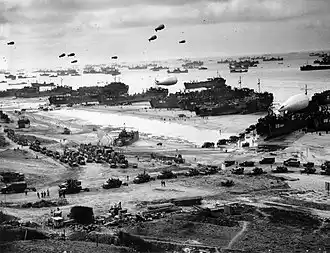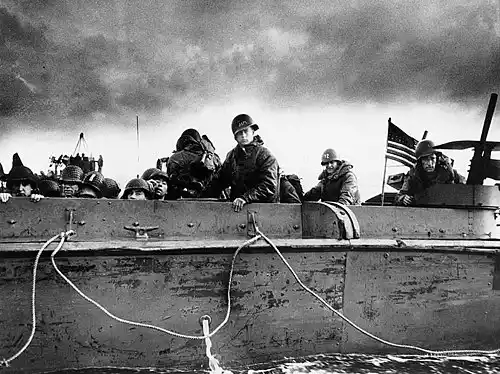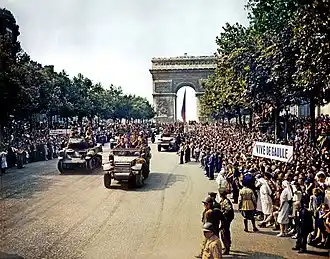
D-Day or ‘Day-Day’, as it actually stands for, was an event which took place on the 6th of June 1944 as the Western Allies began the invasion of Nazi-occupied Western Europe during the Second World War. The D-Day landings took place along the coast of Normandy in northern France. Prior to the amphibious landings, some 24,000 airborne soldiers were parachuted further inland. Then approximately 350,000 Allied troops, primarily from Britain, the United States and Canada, were involved in Normandy landings. D-Day began a period of rapid liberation of France and Belgium, followed by the invasion of western Germany that winter, and the final Allied defeat of Nazi Germany in the spring and early summer of 1945. The D-Day landings led to mass-migration around Europe, and further migration of millions of people later on. Migration from even further afield increased as well since the populations which had been dispersed or killed during the fighting were replaced or returned home.[1]
Chronology of events of D-DayChronology of events of D-Day
Second world war beginningsSecond world war beginnings
The Second World War had started in Europe in September 1939 and for over two years seemed doomed to result in the victory of Nazi Germany and the other Axis powers.[2] But the tide turned in a couple of crucial months at the end of 1941 as first the German invasion of the Soviet Union failed to end in a swift victory and the German Wehrmacht became bogged down in the Russian winter and then the Empire of Japan attacked the United States, drawing the great American power into the conflict directly. With these developments a new alliance of Britain, the Soviet Union, the United States, Canada and other powers emerged. The first major victories they scored were in North Africa against the Germans and Italians in 1942 and in the summer of 1943 they crossed the Mediterranean and opened a Southern Front against the Italians in Italy.[3]
Soviet leadershipSoviet leadership
The Soviet leadership continued to press for a Western Front too, one which would force the Germans to redeploy many of their forces to Nazi-occupied France and the Low Countries. The idea here was to speed up the Soviet advance into Poland, Ukraine and then Germany. The Western Allies led by Britain and the US were also anxious to open a Western Front in order to occupy parts of Germany themselves and prevent the entirety of continental Europe falling under Soviet rule after the Nazis were defeated. Thus was born the scheme for Operation Overlord, the broad campaign name for the invasion of France from Britain in the summer of 1944. The first day of the invasion was code-named D-Day.[4]

D-Day occurred on the 6th of June 1944 as over 350,000 Allied troops were engaged in naval landings on several beaches and landing sites across the Normandy coast of northern France. Approximately 150,000 were actually deployed onto the beaches of Normandy. The rest were naval staff and auxiliaries. They faced numerically inferior German forces which were nevertheless entrenched on well-defended turrets that presented an enormous threat. The first action was to secure the landing sites by bombing the German positions and then overrunning the beaches through sheer force of numbers. Then, with the landing sites secure, transport ships began unloading men and hundreds of armored vehicles and even tanks. It was an immense operation.[5]
Liberation of FranceLiberation of France

D-Day was just the first step in the wider liberation of France. While some beachheads were secured, the progress was slow as the Allies faced extensive resistance across Normandy in the course of June, only capturing the port of Cherbourg after three weeks. Intense fighting and a Nazi counterattack followed in July, but by the end of that month Normandy and other sites in northern France were secured. Matters eased in August as the British, Americans, Canadians and Free French pushed on towards Paris, aided by the opening of a second front in France after an Allied invasion of Provence on the country’s Mediterranean coast. Paris was liberated on the 25th of August after a nearly week-long battle. The stage was set in the process for an eastwards drive towards Germany.[6]
Extent of Migration associated with D-DayExtent of Migration associated with D-Day
Migration to GermanyMigration to Germany
D-Day and the wider Allied invasion of Western Europe in the summer of 1944 were responsible for a lot of varied migration. The most notable element of this lay in the movement of people across the continent when the war came to an end a year later in Europe. For instance, severe labor shortages in Germany and the need to rebuild the country from the summer of 1945 through to the 1960s saw millions of people move to the country, coming in large numbers from countries like Italy and Turkey in search of good jobs in post-war Germany. Similarly, the end of the war, which D-Day did so much to bring about, saw new waves of migrants to Britain, many coming from its Caribbean colonies such as Barbados and Jamaica, a migration which went on for decades and changed the demography of modern Britain.[7]
Migration to AmericaMigration to America
Other migration is less well-known about. Tens of thousands of American and Canadian GIs entered relationships with women from Britain, France, Germany and other regions while they were either stationed in Britain prior to D-Day or in liberated Europe after D-Day. Many of these relationships ended in marriage and tens of thousands of European women ended up living in North America after the war.[8] Finally, the end of the conflict in Europe saw new waves of Jewish migration from the continent to the Levant where the state of Israel was officially founded not long afterwards. Between its foundation in 1948 and 1952 nearly three-quarters of a million Jews arrived to Israel.[9]
Demographic impact of D-DayDemographic impact of D-Day
The demographic impact was varied and felt in a great many countries. The so-called Windrush Generation of Caribbean and other colonial migrants to Britain have left a lasting legacy on the multiculturalism of the United Kingdom today. Millions of Germans have Turkish blood as a result of the ‘guest worker’ system which was created to combat labor shortages there after the war. Israel has been fundamentally shaped by the influx of hundreds of thousands of Jews into the Levant in the second half of the 1940s who had survived the Holocaust. Of those who arrived between 1948 and 1952 some 300,000 came from Poland, Hungary, Czechoslovakia, Romania and Bulgaria, countries liberated as part of the wider war in Europe in and around D-Day.[9]
See alsoSee also
Explore more about D-DayExplore more about D-Day
- U.S. World War II Army Enlistment record collection on MyHeritage
- World War II Reserve Corps Records record collection on MyHeritage
- British Army Roll of Honour, 1939-1945 record collection on MyHeritage
- Death and Burial Practices in World War I and WW II at Legacy Family Tree Webinars
- Researching Your World War II Ancestors: Part 2 – Records of the Army at Legacy Family Tree Webinars
- World War II Heroes – Telling Their Stories at Legacy Family Tree Webinars
- He Found 357 Letters His Uncle Wrote Before Falling in Battle During WWII at the MyHeritage blog
- A Bittersweet D-Day Love Story Comes Full Circle as Brothers Find Each Other After 70 Years at the MyHeritage blog
- D-Day in Full Color at the MyHeritage blog.
References
- ↑ D-DayU.S. Army
- ↑ AXIS POWERS IN WORLD WAR II. United States Holocaust Memorial Museum
- ↑ Second World War. National Army Museum
- ↑ The 10 Things you Need to Know about D-Day. Imperial War Museums
- ↑ D-Day. History Channel
- ↑ Timeline: The War in Europe, After D-Day. National Public Radio
- ↑ What is Windrush and who are the Windrush generation?. BBC News
- ↑ A Look At The GI Brides of The Second World War. The British Newspaper Archive
- ↑ 9.0 9.1 Immigrants to Israel: 1948-1952. Jewish Virtual Library

